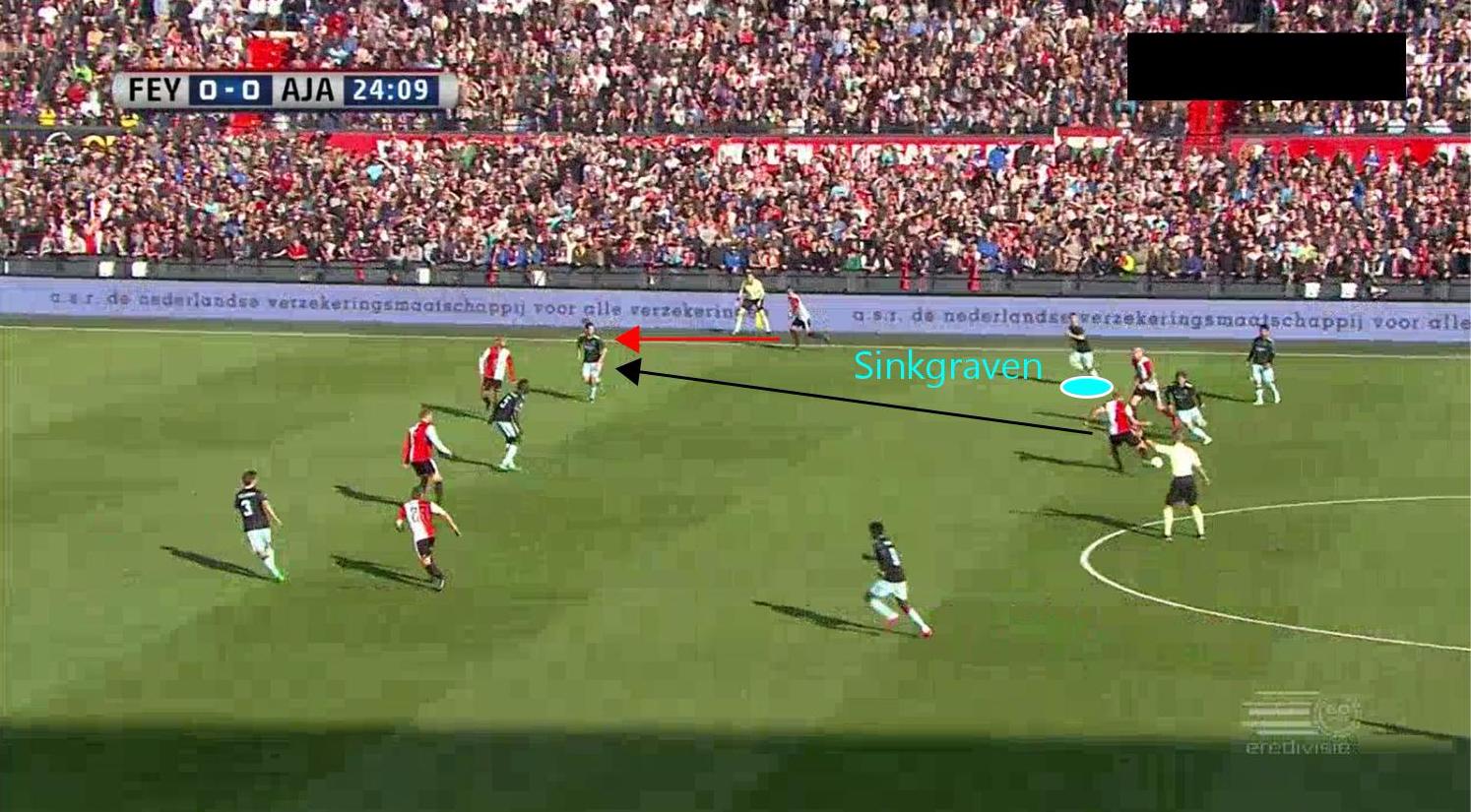Edin Halilovic writes a detailed tactical analysis about the Eredivisie match that ended Feyenoord 1-1 Ajax.
High-flyers Feyenoord had a chance to make it ten wins from ten in the Eredivisie and open up a sizable lead at the top of the league by recording their first league win over Ajax since January 2012 on Sunday afternoon. They failed to do so and just about managed to avoid defeat with a late equalizer, but still remain in control of first place in the standings early on in the campaign.

Feyenoord: 25. Jones; 2. Karsdorp, 33. Botteghin, 6. Heijden, 4. Kongolo; 8. Ahmadi, 7. Kuyt, 10. Vilhena; 14. Basacikoglu, 9. Jorgensen, 28. Toomstra.
Ajax: 24. Onana; 3. Veltman, 5. Sanchez, 26. Viergever, 8. Sinkgraven; 10. Klaassen, 20. Schone, 22. Ziyech; 9. Traore, 25. Dolberg, 11. Younes.
Fervent Start

As expected in a game of such importance between two rivals who like to play with the ball at their feet, the early phase of the match oversaw a start of intense, high pressing with both sides signaling their intent to play bravely and courageously from the kick-off by not giving one another much time on the ball to build any rhythm.
Ajax were perhaps the braver and fiercer of the two in this department from the beginning as they sent several players forward to chase down the ball in their attempts to win back possession. As they often do, they used a leeway-oriented pressing variant which allowed them to pin Feyenoord into corners and made it difficult for them to progress the ball into advanced positions, which led to the home side sending the ball long or backwards on multiple occasions with few forward passing options available.

Feyenoord similarly used a leeway press and closed off the opposing ball carrier’s passing options well with their cover shadows which, along with Ajax’s midfield disconnections in positional play, rendered the Amsterdam-based side to also play the ball back or long more often than they’d generally have liked. Feyenoord’s press though was a bit different though in the sense that it was largely conducted by the forward players with the midfielders dropping deeper to defend the space in front of their defense while Ajax’s did not when they were the ones doing the pressing.
The first half was mostly a pressing battle with few chances of note created on either side as both sets of players generally gave each other little time on the ball and struggled with their offensive spcing, especially once they entered the attacking half of the pitch. The intensity of the pressing did slow down a bit after just over 20 minutes and both teams began to settle into passing rhythms afterward as the game grew older.
Mixed results in wide-based attacking approaches
Due to the build-up and structural problems the two teams had, their best hopes of conjuring up chances on the offensive end at times came down to adjusting their strategies to play through the flanks with diagonal ball circulation to the players waiting in wider positions.
With dynamic attacking fullbacks and a direct, forward thinking player that likes to spread the play in veteran Dirk Kuyt, Feyenoord were more comfortable with this approach as they targeted Ajax’s lack of pace and defensive support from their wingers by sending their fullbacks into forward positions when they could, mainly Terence Kongolo, to try and exploit the spaces behind them with an extra man in attack. They often used combination plays to get in behind the Ajax fullbacks and frequently succeeded in doing so, but their final ball ultimately let them down in promising situations more often than not.

Ajax’s fullbacks weren’t afraid to get forward either whenever they could and they similarly looked to combine with close-by teammates to attract runners and break Feyenoord’s flanks down by exploiting the space that was created in behind them. Although Ajax didn’t go down this route as often as Feyenoord did as they primarily opted to try and play through the central areas, they did make use of their extra men in attacks with Joel Veltman and Daley Sinkgraven’s overlaps albeit with little success in their end product in good positions out wide.

With the two teams canceling each other out in midfield and opting to attack through the flanks but with little success due to their poor final balls, this limited a number of players on the pitch on either side with midfielders like Karim El Ahmadi, Tonny Vilhena, and Davy Klaassen seeing a lot less of the ball than they’re used to. That, along with the poor deliveries into the box from the wide players, saw both forwards Nicolai Jorgensen and Niklas Dolberg, particularly the former, get very little service in the box and struggle to get involved in the game with both centerback pairings opting to be physical with the strikers as a result of not having as much to defending to do through the middle with the bulk of the game’s attacks mainly coming through the flanks.
One of the key battles going into the game was expected to come on the flanks with Feyenoord’s offensive minded fullback Rick Karsdorp coming up against the pacey, skillful young German winger Amin Younes. With Karsdorp having an eye for going forward and sometimes putting his defensive duties in the backseat, that was an area where it was believed that Ajax could hurt Feyenoord but Karsdorp managed to contain Younes well and stick to his primary tasks for much of the game. He took up a more conservative approach to the game upon instruction and left the attacking to Kongolo on the other side as he rarely pushed forward to offer an extra body in attack, opting to stay deeper and closer to Younes in order to not get caught out on the counter knowing full well what the German is capable of with the ball at his feet. Although Younes didn’t have a particularly influential game by his standards, Karsdorp’s positional discipline was key for Feyenoord in not allowing Ajax to find much success in their attacks down the left hand side.

Second Half
The second half started where the first half had left off but the big difference was that there was a goal early on in the half with Niklas Dolberg producing a composed chip finish to give Ajax a lead against the run of play. That goal opened the game up as the spaces began to appear on both sides as they searched for the critical second goal in the game.
Giovanni van Bronckhorst immediately made a couple of offensive switches shortly after Dolberg’s strike with the explosive Eljero Elia and the tenacious Steven Berghuis replacing Jens Toornstra and Bilal Basacikoglu as the two wingers to offer more direct, dynamic options to their attack. The spaces began to appear in both teams and on the other end, Hakim Ziyech and Bertrand Traore were making good use of it on by breaking Feyenoord’s defensive shape with their dribbling and vertical passing as Ajax started to produce more qualitative counters than they did in the first half, albeit with no end result.
Ziyech’s injury dealt a blow to Ajax’s midfield as they lost their orchestrator and link between midfield and attack which ended up hurting their counters for the remainder of the game while their eagerness to attack and lack of experienced heads on the pitch wasn’t very well disguised either.

Instead of focusing on trying to keep the ball better by playing closer together after going ahead, Peter Bosz’s men went in search of a second goal to kill the game off and ended up shooting themselves in the process with this near gung-ho approach. Their team structure was abandoned with several players trying to go forward to support attacks while the defense operated in a very deep line, which created huge disconnects in the team and made it difficult for them to string good passing moves together like they had done earlier in the game. This resulted in them playing many long clearances late on and giving the ball back to Feyenoord who relentlessly kept attacking in search of a goal. They became far too opened up for counters which Feyenoord eventually took advantage of and their lack of positional discipline ended up costing them two points that could cost them at the end of the season.
Conclusion
Despite Dolberg’s second half goal and the amount of space they were given afterward on the counter, Ajax failed to see out the game with their lead intact due to their own lack of tactical discipline and experience in the side as Feyenoord’s pressure finally told late on in the game with Kuyt equalizing. A draw isn’t the worst result for either side, although both teams will walk away from the match feeling that they could have done more to win it.
However, despite seeing their 100% record come to an end here, with Feyenoord holding a five point lead at the top of the Eredivisie, they’ll probably be the happier of the two teams with the result. Particularly given the fact that they managed to escape defeat via a late goal.
Read our other tactical analyses here.
- Tactical Analysis: Athletic Bilbao 2-2 Atletico Madrid | All square at San Mames - February 3, 2017
- Scout Report: Gabriel Jesus | Manchester City’s new Brazilian starlet - January 5, 2017
- Tactical Analysis: Bayern Munich 1-1 Hoffenheim | Sinsheim club remain unbeaten - November 15, 2016
























































